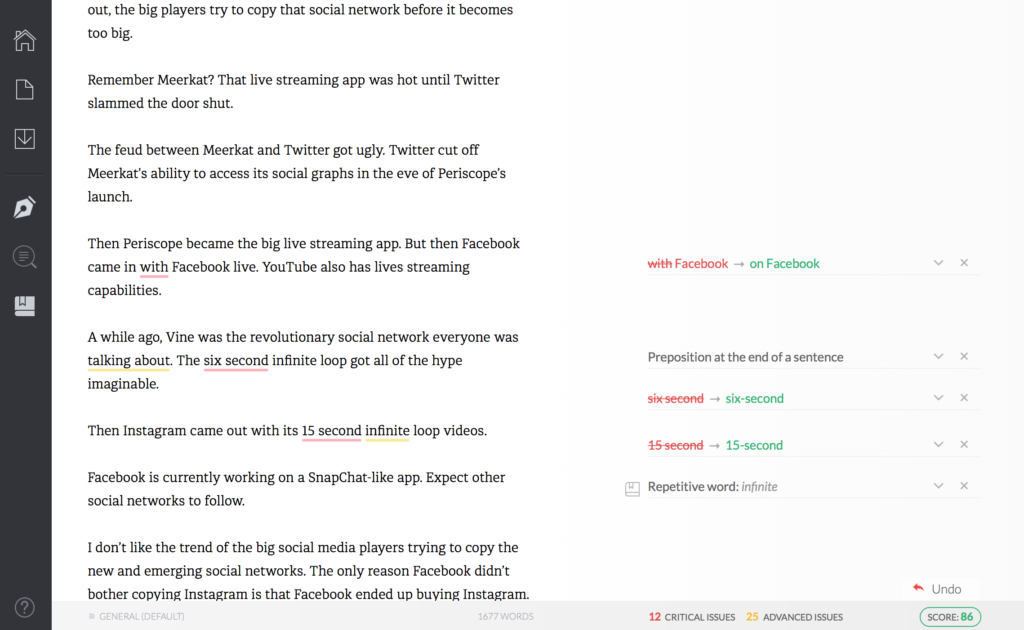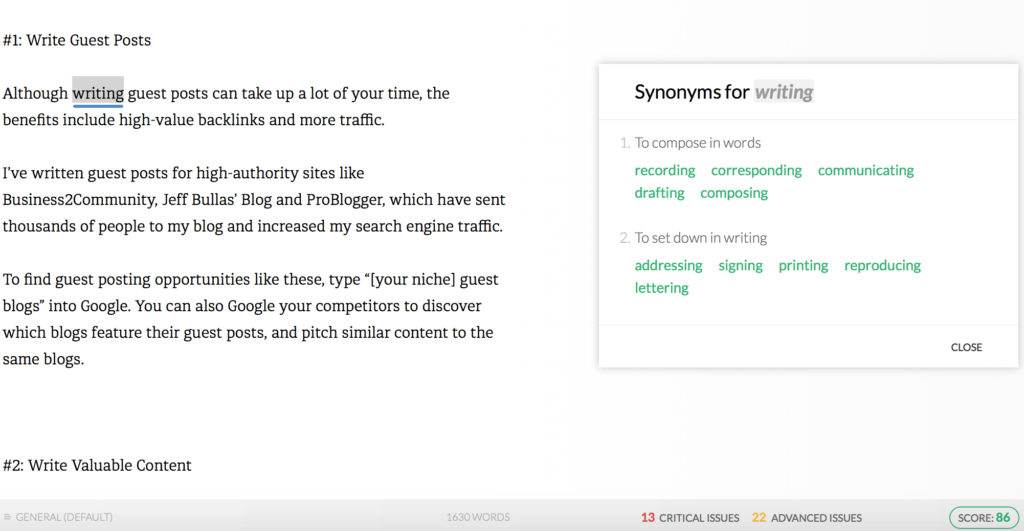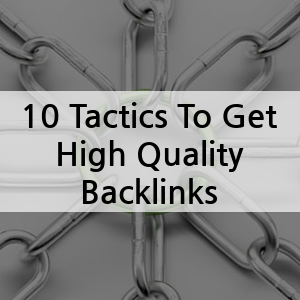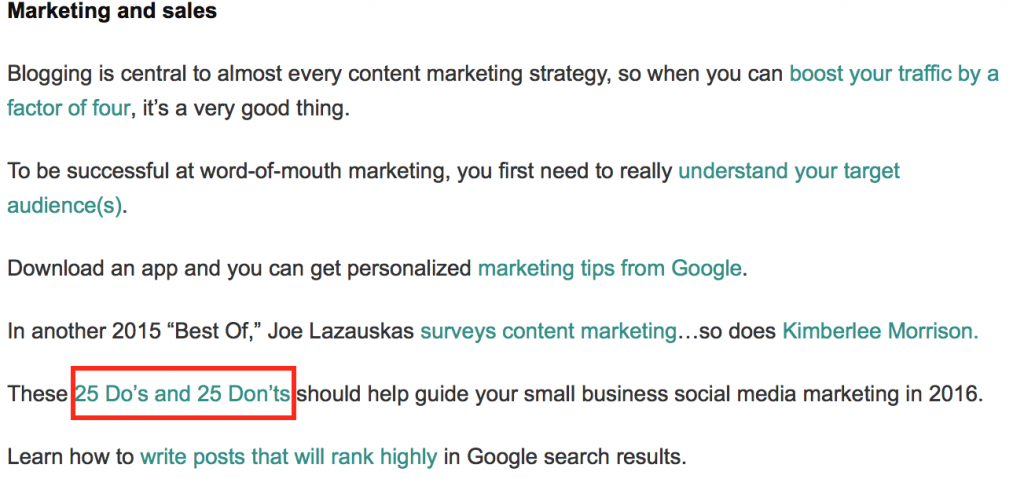
My mom was the first person to tell me about Grammarly. At that first instance, this tool was pitched as a way to get better grades on my school essays. Before I could blink, I was suddenly a Grammarly customer.
My mom created an account, and Grammarly went to work revealing all of the mistakes in my school essays. As I aced more of my school essays, I stopped using Grammarly because I no longer needed it for that purpose.
That experience with Grammarly helped me get better grades, but that experience limited my view of the online tool. I viewed Grammarly as an academic tool. Nothing more and nothing less. I never thought of using it to strengthen my blog posts.
It wasn’t until I started listening to the EOFire podcast more often that I considered Grammarly as a force to be reckoned with. After hearing several advertisement of the tool on the EOFire podcast I knew I had to give it some consideration.
I was suddenly off to the races. I created my account and put in my blog posts. Here’s what happened…
I Got My Grade
My blog post got a B+ on Grammarly. While that’s not a bad grade, I need the A for the blog posts I write on this blog. I take this blog far more seriously now than I did a few years ago.
I take my content so seriously that I recently decided to hire an editor. Now I’m using Grammarly to make my content even better. My mistakes on Grammarly weren’t the obvious mistakes that everyone finds. Going in, I knew I wouldn’t spell any of the words wrong because I always spell check my content in advance.
Spelling errors don’t exist in my blog posts. Word repetition, the incorrect words, and other errors do exist in my content. Grammarly allows me to identify and find these errors before I publish my blog posts (and then my readers find the errors. Ouch).
In a paragraph that seemed solid, Grammarly identified five mistakes within the content. While the on Facebook correction doesn’t seem accurate, the others are spot on. Within the dashboard, I can see when I end sentences with a preposition.

While it’s necessary to end certain sentences with prepositions, I always wonder how I can improve these sentences to evade the preposition as the final word in a sentence. The dashboard also pointed out certain mistakes I didn’t even know about such as six-second requiring the hyphen in the middle.
What’s The Big Deal About Getting The A?
Blog posts are written more loosely than school essays. Sometimes when I write school essays, I have to remind themselves that they aren’t blog posts.
Or else I’ll write a short paragraph like the one above. Or else I’ll actually start two sentences with conjunctions in succession.
When Grammarly puts that grade for my content, I take it very seriously. I do what it takes to get that grade up to an A. Why does an A matter to me so much?
Because that’s what Neil Patel gets for his blog posts.
Upon one of my recent visits to the QuickSprout blog, I decided to copy and paste Neil’s five most recent blog posts into Grammarly. The plagiarism percentage was in the high 90s, so I promptly turned it off.
Only one of those five blog posts was under 90%. That particular blog post scored an 86%. All of his other blog posts I checked were in the 90-91% threshold. If I could automatically write content like a single blogger, I would choose Neil.
With that said, I don’t compare myself to Neil every single day because comparing yourself to others is a great way to bring yourself down. I wouldn’t go from an 80% to a 95% because I want to email Neil and let him know Grammarly likes my content a little better than his.
I want to make that change in my content because I know I’ll come out with better content.
Polish Up Your Writing
Grammarly is NOT just a way for you to spot careless mistakes. Grammarly can help you write better content. One cool feature about Grammarly is that by highlighting a word, you get synonym options.
In one of my blog posts, I was overusing the word “writing.” Here’s an example of how someone can overuse the word:
Writing guest posts helps you improve your writing. If you begin writing every day, your guest posts will get better and people will notice your better writing.
I use the same word four times in two sentences. It’s very hard to read, but Grammarly comes to the rescue. If you highlight the word as I did in this instance, you will see some synonyms.

Not all of those words could replace “writing” based on the context it’s used. But composing sounds sweet. Now you’re not just writing, but you are composing a piece in which many elements must come together in a symphony.
I would have never considered thinking of myself composing blog posts if I didn’t see that synonym.
Do I Still Need An Editor?
Grammarly does what the name suggests. It helps you find all of the grammatical mistakes within your content. So with that said, can it replace my editor?
Nope. My editor doesn’t just find mistakes Grammarly finds, but she also strengthens my content by conducting research and rewording certain parts to make the content more appealing.
With that said, Grammarly and an editor go hand-in-hand. You don’t want an editor correcting your spelling mistakes and your misuse of the English language. Grammarly does that for you, and your editor will have a much easier time correcting those mistakes if he/she uses Grammarly.
That way, your editor can focus on content research and content development instead of searching for mistakes that Grammarly can find in a few seconds.
In Conclusion
For a long time, I viewed Grammarly as an academic tool and never gave much thought about using it for my blog posts. When I first used the online tool, it helped me go from a low 70 to a high 90 (based on its grading system).
Now I use it for my blog posts because I’m not satisfied with a B+. I want all of my future blog posts in the 90-95% threshold. The only reason I don’t want my blog posts to be in the 100% threshold is because there are some mistakes that I disagree with.
Writing better content isn’t just a matter of practicing each day and finishing your blog posts. Great content starts off good and becomes great with proofreading and editing.
If you are interested in using Grammarly to improve your content, I urge you to give it a try.




